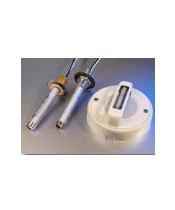Vertical and horizontal mounting DETECT-A-FIRE® (DAF) heat detectors utilize the rate compensation principle which ignores rate-of-rise and thermal lag to respond precisely at set-point.
DAF® heat detectors are vibration resistant and have hermetically sealed contacts with significant explosion proof and intrinsically safe listings.
Detect-A-Fire

DETECT-A-FIRE® (DAF®) units have met with wide acceptance because they are designed with rate compensation. This provides a unique advantage over both fixed temperature andrate-of-rise types of detectors because only the DAF® unit accurately senses the surrounding air temperature regardless of the fire growth rate. At precisely the predetermined danger point, the system is activated.
Fixed temperature detectors must be completely heated to alarm temperature and therefore a disastrous lag in time may occur with a fast rate fire.
Rate-of-rise devices, on the other hand, are triggered by the rate of increase in ambient temperature and are subject to false alarms caused by harmless, transient thermal gradients such as the rush of warm air from process ovens.
The secret of the unit’s sensitivity is in the design. The outer shell is made of a rapidly expanding alloy which closely follows changes in surrounding air temperature. The inner struts are made of a lower expanding alloy.
Designed to resist thermal energy absorption and sealed inside the shell, the struts follow temperature changes more slowly.
A slow rate fire will heat the shell and struts together. At the “set point”, the unit will trigger, actuating the alarm or releasing the extinguishant. A transient rush of warm air up to 40ºF /min. may expand the shell, but not enough to trigger the unit. By ignoring transient warm air excursions, the DAF® unit virtually eliminates false alarms prevalent with rate-of-rise devices.
If a fast rate fire starts, the shell will expand rapidly. The struts will close, actuating the alarm or releasing the agent. The faster the fire rate of growth, the sooner the DAF® unit will react.




